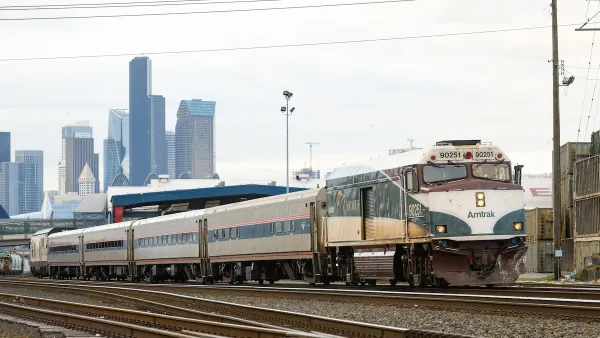GOOD Magazine sends a reporter across country on Amtrak to give a riders-eye view of the system.
"With no rush about me, here I was, on a trip from New York to San Francisco that runs exactly 3,397 miles, rolling through 11 states, on two legendary rail routes-the Lake Shore Limited (from New York to Chicago) and the California Zephyr (from Chicago to just outside San Francisco). This could take exactly 77 hours and 15 minutes, if the trains keep to schedule. Most likely, they won't.
The American passenger rail-once a model around the globe-is now something of an oddball novelty, a political boondoggle to some, a colossal transit failure to others. The author James Howard Kunstler likes to say that American trains "would be the laughing stock of Bulgaria." The numbers show just how far this once-great system has fallen. In 1960, U.S. rail travelers logged 17.1 billion passenger miles (the movement of one passenger one mile), the standard measure of a system's reach; by 2000, that number had fallen to 5.5 billion, just one percent of the total travel between U.S. cities that year. (Of course, over this same period, airlines' passenger miles increased 16 times; even intercity buses' service nearly doubled.) Most of this decrease was seen in the 1960s, as highways and air travel took precedent both in travel plans and in government subsidies. Since its ill-fated formation as a quasi-public, for-profit corporation in 1971, Amtrak has seen only meager growth and loses billions of dollars annually."
FULL STORY: Train in Vain

National Parks Layoffs Will Cause Communities to Lose Billions
Thousands of essential park workers were laid off this week, just before the busy spring break season.

Retro-silient?: America’s First “Eco-burb,” The Woodlands Turns 50
A master-planned community north of Houston offers lessons on green infrastructure and resilient design, but falls short of its founder’s lofty affordability and walkability goals.

Delivering for America Plan Will Downgrade Mail Service in at Least 49.5 Percent of Zip Codes
Republican and Democrat lawmakers criticize the plan for its disproportionate negative impact on rural communities.

Test News Post 1
This is a summary

Test News Headline 46
Test for the image on the front page.

Balancing Bombs and Butterflies: How the National Guard Protects a Rare Species
The National Guard at Fort Indiantown Gap uses GIS technology and land management strategies to balance military training with conservation efforts, ensuring the survival of the rare eastern regal fritillary butterfly.
Urban Design for Planners 1: Software Tools
This six-course series explores essential urban design concepts using open source software and equips planners with the tools they need to participate fully in the urban design process.
Planning for Universal Design
Learn the tools for implementing Universal Design in planning regulations.
EMC Planning Group, Inc.
Planetizen
Planetizen
Mpact (formerly Rail~Volution)
Great Falls Development Authority, Inc.
HUDs Office of Policy Development and Research
NYU Wagner Graduate School of Public Service



























